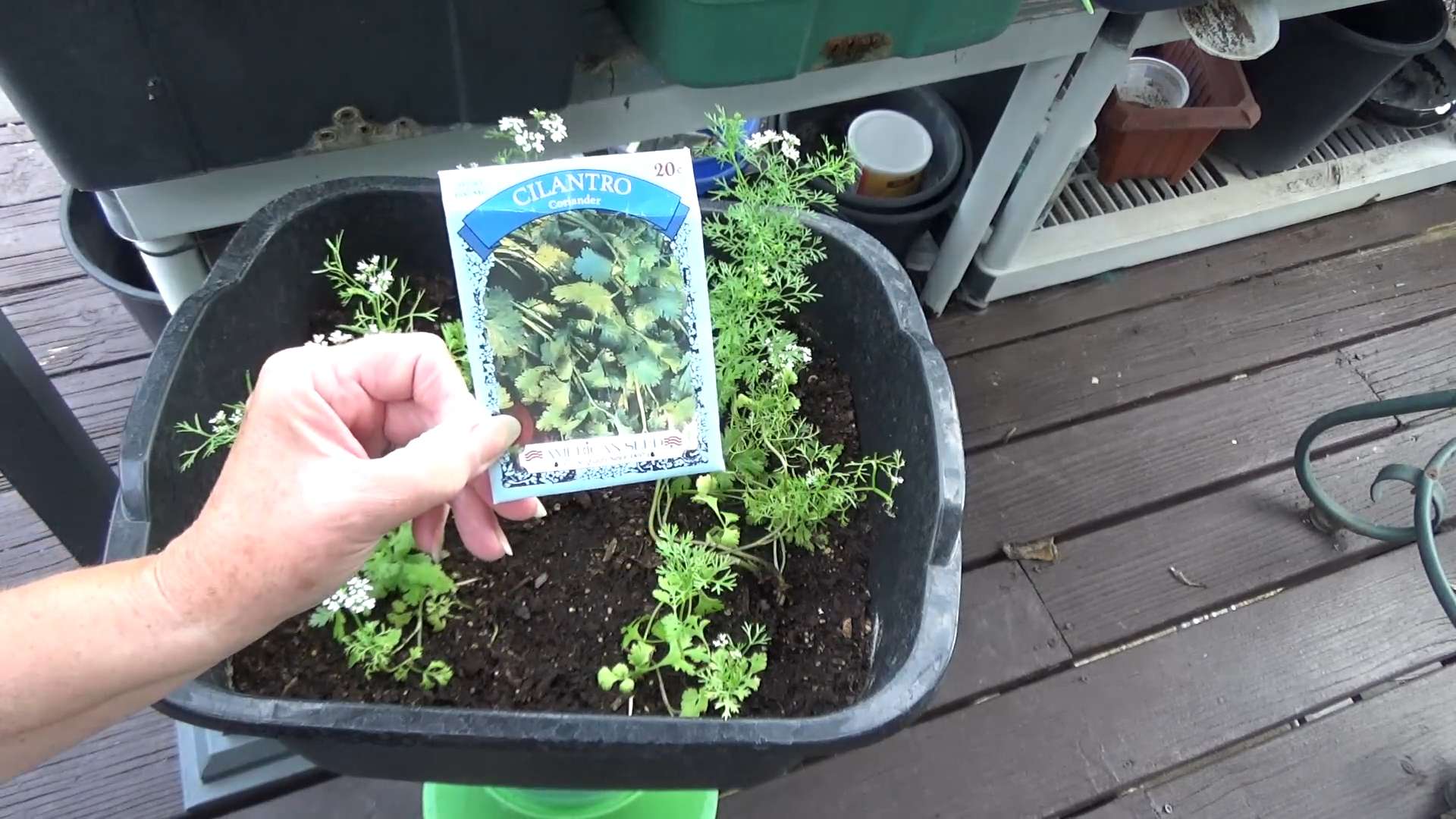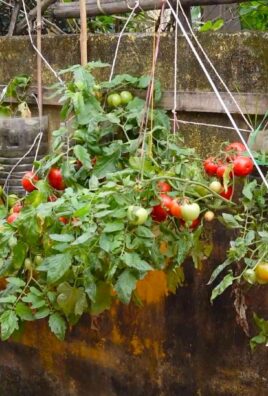Growing Cilantro at Home can feel like a culinary quest, right? I know I’ve been there! You’re dreaming of fresh salsa, vibrant tacos, and that perfect finishing touch on your favorite dishes, only to find your cilantro bolted before you even get a decent harvest. But don’t worry, I’m here to share some simple DIY tricks that will transform your cilantro-growing experience from frustrating to fantastic!
Cilantro, also known as coriander (the seeds!), has a rich history, dating back to ancient Egypt where it was even found in Tutankhamun’s tomb! For centuries, cultures around the world have cherished it for its unique flavor and medicinal properties. But let’s be honest, buying cilantro from the store can be a gamble – sometimes it’s wilted, sometimes it’s expensive, and sometimes it just doesn’t have that fresh, vibrant taste you’re craving.
That’s where these DIY hacks come in. I’m going to show you how to easily start growing cilantro at home, even if you have limited space or a less-than-green thumb. These tips will help you extend your harvest, prevent bolting, and enjoy a constant supply of fresh, flavorful cilantro right at your fingertips. Get ready to ditch the store-bought bunches and embrace the joy of homegrown goodness!

Growing Cilantro at Home: A Beginner’s Guide
Hey there, fellow plant enthusiasts! Ever find yourself constantly buying cilantro at the grocery store, only for it to wilt away in your fridge before you can use it all? I know I have! That’s why I decided to take matters into my own hands and start growing my own cilantro at home. And guess what? It’s way easier than you might think! This guide will walk you through everything you need to know to have a thriving cilantro patch right in your kitchen or garden.
What You’ll Need
Before we dive in, let’s gather our supplies. Here’s a checklist of everything you’ll need to successfully grow cilantro:
* Cilantro Seeds: You can find these at most garden centers or online. Make sure to get seeds specifically for growing cilantro, not coriander (which is the same plant, but the seeds are harvested for spice).
* Potting Soil: Use a well-draining potting mix. Avoid using garden soil, as it can be too heavy and compact for container gardening.
* Container: Choose a pot that’s at least 6 inches deep and wide. Cilantro has a taproot, so it needs enough space to grow. A larger pot is always better!
* Watering Can or Spray Bottle: For gentle watering.
* Sunny Location: Cilantro needs at least 4-6 hours of sunlight per day. A south-facing window or a sunny spot in your garden is ideal.
* Optional: Seed Starting Tray: If you prefer to start your seeds indoors before transplanting them.
* Optional: Plant Food: A balanced liquid fertilizer can help boost growth, but it’s not essential.
Starting Your Cilantro Seeds
There are two main ways to start your cilantro seeds: directly sowing them into your container or starting them indoors in a seed starting tray. I’ll cover both methods below.
Method 1: Direct Sowing
This is the easiest and most common method, especially if you live in a warmer climate.
1. Prepare Your Pot: Fill your chosen container with potting soil, leaving about an inch of space at the top. Gently pat down the soil to create a level surface.
2. Sow the Seeds: Cilantro seeds are actually small fruits containing two seeds each. To improve germination, you can gently crush the seeds between two hard surfaces (like two plates or a rolling pin) to separate the two seeds inside. Don’t crush them too hard, though!
3. Space the Seeds: Sprinkle the seeds evenly over the surface of the soil. Aim for about 1-2 inches of space between each seed.
4. Cover the Seeds: Lightly cover the seeds with about ¼ inch of potting soil.
5. Water Gently: Use a watering can or spray bottle to gently water the soil until it’s moist but not soggy.
6. Provide Sunlight: Place your pot in a sunny location where it will receive at least 4-6 hours of sunlight per day.
7. Keep the Soil Moist: Keep the soil consistently moist, but not waterlogged. Check the soil daily and water when the top inch feels dry to the touch.
8. Germination: Cilantro seeds typically germinate in 7-10 days. Be patient!
9. Thinning (Optional): Once the seedlings emerge, you may need to thin them out if they’re too crowded. Snip off the weaker seedlings at the base, leaving the strongest ones to grow.
Method 2: Starting Seeds Indoors
This method is helpful if you want to get a head start on the growing season or if you live in a colder climate.
1. Prepare Your Seed Starting Tray: Fill the cells of your seed starting tray with potting soil.
2. Sow the Seeds: Follow steps 2-4 from the direct sowing method, placing 2-3 seeds in each cell.
3. Water Gently: Water the soil until it’s moist but not soggy.
4. Provide Light: Place the seed starting tray under a grow light or in a sunny window.
5. Keep the Soil Moist: Keep the soil consistently moist.
6. Transplant Seedlings: Once the seedlings have developed a few sets of true leaves (usually after 2-3 weeks), you can transplant them into your chosen container. Gently remove the seedlings from the seed starting tray and plant them in the container, spacing them about 1-2 inches apart.
7. Water After Transplanting: Water the seedlings thoroughly after transplanting.
Caring for Your Cilantro Plant
Once your cilantro seedlings have emerged, it’s important to provide them with the right care to ensure they thrive.
* Watering: Cilantro needs consistent moisture, but it doesn’t like to be waterlogged. Water when the top inch of soil feels dry to the touch. Avoid overwatering, as this can lead to root rot.
* Sunlight: Cilantro needs at least 4-6 hours of sunlight per day. If you’re growing it indoors, make sure it’s in a sunny window. If you’re growing it outdoors, choose a location that receives plenty of sunlight.
* Temperature: Cilantro prefers cooler temperatures, ideally between 60-70°F (15-21°C). Hot weather can cause it to bolt (go to seed), which will make the leaves taste bitter.
* Fertilizing (Optional): You can fertilize your cilantro plant every 2-3 weeks with a balanced liquid fertilizer. Follow the instructions on the fertilizer label.
* Pest Control: Cilantro is generally pest-resistant, but it can sometimes be affected by aphids or spider mites. If you notice any pests, you can spray them with insecticidal soap or neem oil.
* Bolting Prevention: As I mentioned earlier, cilantro tends to bolt in hot weather. To prevent bolting, try to keep the plant in a cooler location, provide it with afternoon shade, and water it regularly. You can also pinch off any flower buds that appear.
Harvesting Your Cilantro
The best part about growing your own cilantro is, of course, harvesting it! You can start harvesting cilantro leaves when the plant is about 6-8 inches tall.
1. Harvesting Leaves: Use scissors or your fingers to snip off the outer leaves of the plant, leaving the inner leaves to continue growing.
2. Regular Harvesting: Regular harvesting will encourage the plant to produce more leaves.
3. Harvesting Seeds (Optional): If you want to harvest cilantro seeds (coriander), allow the plant to flower and go to seed. Once the seeds are dry and brown, you can harvest them and use them as a spice.
Troubleshooting
Even with the best care, you might encounter some problems while growing cilantro. Here are a few common issues and how to address them:
* Yellowing Leaves: This can be caused by overwatering, underwatering, or nutrient deficiencies. Check the soil moisture and adjust your watering accordingly. You can also try fertilizing the plant with a balanced liquid fertilizer.
* Leggy Growth: This is usually caused by insufficient sunlight. Make sure your cilantro plant is getting enough light.
* Bolting: As mentioned earlier, bolting is caused by hot weather. Try to keep the plant in a cooler location and provide it with afternoon shade.
* Pests: If you notice any pests, spray them with insecticidal soap or neem oil.
Extending Your Cilantro Harvest
Cilantro is an annual plant, which means it completes its life cycle in one year. However, you can extend your cilantro harvest by following these tips:
* Succession Planting: Sow new seeds every 2-3 weeks to ensure a continuous supply of cilantro.
* Pinching Off Flower Buds: Pinching off flower buds will prevent the plant from bolting and encourage it to produce more leaves.
* Growing in Partial Shade: Growing cilantro in partial shade can help keep it cooler and prevent bolting.
* Harvesting Regularly: Regular harvesting will encourage the plant to produce more leaves.
Enjoy Your Fresh Cilantro!
Now that you know how to grow cilantro at home, you can enjoy fresh, flavorful cilantro whenever you want! Add it to your favorite tacos, salsas, soups, and salads. The possibilities are endless! I hope this guide has been helpful. Happy gardening!

Conclusion
So, there you have it! Growing cilantro at home is not only achievable, but it’s also a game-changer for anyone who loves fresh, vibrant flavors in their cooking. Forget those sad, wilted bunches from the grocery store that cost a fortune and disappear within days. With a little effort and the right approach, you can have a constant supply of this beloved herb right at your fingertips.
Why is this DIY trick a must-try? Because it empowers you to control the quality and freshness of your cilantro. Imagine the satisfaction of snipping off exactly what you need, knowing it’s bursting with flavor and free from pesticides. Plus, it’s incredibly cost-effective in the long run. Think of all the money you’ll save by not having to constantly repurchase cilantro!
Beyond the basic method, there are plenty of ways to customize your cilantro-growing experience. Consider these variations:
* **Succession Planting:** Plant new seeds every few weeks to ensure a continuous harvest. Cilantro tends to bolt (go to seed) quickly, especially in hot weather, so staggering your plantings will keep you in fresh cilantro all season long.
* **Container Gardening:** If you’re short on space, cilantro thrives in containers. Choose a pot that’s at least 6 inches deep and wide to give the roots plenty of room to grow.
* **Hydroponics:** For a more advanced approach, try growing cilantro hydroponically. This method can yield faster growth and higher yields.
* **Different Varieties:** Explore different varieties of cilantro, such as ‘Santo’ or ‘Slow Bolt’, which are known for their resistance to bolting.
Don’t be intimidated if you’re a beginner gardener. Growing cilantro at home is surprisingly easy, and the rewards are well worth the effort. The fresh, zesty flavor of homegrown cilantro will elevate your dishes to a whole new level. From tacos and salsas to curries and salads, the possibilities are endless.
We wholeheartedly encourage you to give this DIY trick a try. Start small, experiment with different methods, and don’t be afraid to make mistakes. Gardening is a learning process, and every failure is an opportunity to improve.
And most importantly, we want to hear about your experience! Share your tips, tricks, and triumphs in the comments below. Let us know what worked for you, what challenges you faced, and what delicious dishes you created with your homegrown cilantro. Together, we can build a community of cilantro-loving gardeners and inspire others to embrace the joy of growing their own food. So, grab your seeds, get your hands dirty, and start growing your own **cilantro** today!
Frequently Asked Questions (FAQ)
Why does my cilantro keep bolting?
Bolting, or going to seed, is a common problem with cilantro. It’s triggered by stress, usually heat or lack of water. To prevent bolting, try these tips:
* **Plant in the right season:** Cilantro prefers cool weather. Plant it in early spring or fall.
* **Provide shade:** If you live in a hot climate, provide afternoon shade for your cilantro plants.
* **Water regularly:** Keep the soil consistently moist, but not waterlogged.
* **Choose bolt-resistant varieties:** Look for cilantro varieties like ‘Santo’ or ‘Slow Bolt’.
* **Harvest frequently:** Regular harvesting encourages the plant to produce more leaves instead of flowers.
How much sunlight does cilantro need?
Cilantro needs at least 6 hours of sunlight per day. However, in hot climates, it benefits from some afternoon shade. If you’re growing cilantro indoors, place it near a sunny window or use a grow light.
What kind of soil is best for cilantro?
Cilantro prefers well-draining soil that is rich in organic matter. A good potting mix or garden soil amended with compost is ideal. Avoid heavy clay soils, which can become waterlogged.
How often should I water my cilantro?
Water cilantro regularly, keeping the soil consistently moist but not waterlogged. Check the soil moisture level daily and water when the top inch feels dry. Avoid overwatering, which can lead to root rot.
When should I harvest my cilantro?
You can start harvesting cilantro leaves when the plants are about 6 inches tall. Snip off the outer leaves, leaving the inner leaves to continue growing. Harvest regularly to encourage new growth and prevent bolting.
Can I grow cilantro indoors?
Yes, cilantro can be grown indoors. Choose a pot that’s at least 6 inches deep and wide, and use a well-draining potting mix. Place the pot near a sunny window or use a grow light. Water regularly and fertilize every few weeks.
What fertilizer should I use for cilantro?
Cilantro benefits from a balanced fertilizer, such as a 10-10-10 or 5-5-5. Apply the fertilizer according to the package directions. You can also use organic fertilizers, such as compost tea or fish emulsion.
How do I save cilantro seeds?
If your cilantro plants bolt, you can save the seeds for future planting. Allow the seed heads to dry completely on the plant. Once they are dry, cut them off and store them in a cool, dry place.
My cilantro leaves are turning yellow. What’s wrong?
Yellowing leaves can be a sign of several problems, including overwatering, underwatering, nutrient deficiency, or disease. Check the soil moisture level and adjust your watering accordingly. Fertilize the plants with a balanced fertilizer. If you suspect a disease, treat the plants with an appropriate fungicide.
Can I grow cilantro from cuttings?
While it’s not the most reliable method, you can try growing cilantro from cuttings. Take a cutting from a healthy stem, about 4-6 inches long. Remove the lower leaves and place the cutting in a glass of water. Change the water every few days. Once roots have formed, plant the cutting in a pot of soil.
Is cilantro the same as coriander?
Yes and no. In the United States, the leaves of the *Coriandrum sativum* plant are called cilantro, while the seeds are called coriander. In other parts of the world, the entire plant is referred to as coriander.
How do I prevent pests from attacking my cilantro?
Cilantro can be susceptible to pests such as aphids, spider mites, and whiteflies. To prevent pests, keep your plants healthy and well-watered. Inspect your plants regularly for signs of pests and treat them with an appropriate insecticide if necessary. You can also use organic pest control methods, such as neem oil or insecticidal soap.
What are some good companion plants for cilantro?
Cilantro is a good companion plant for many vegetables, including tomatoes, peppers, and carrots. It can help to repel pests and attract beneficial insects. Avoid planting cilantro near fennel, as they can inhibit each other’s growth.
How long does it take for cilantro to grow from seed?
Cilantro typically takes about 3-4 weeks to germinate and another 4-6 weeks to reach harvest size. The exact time will depend on the growing conditions, such as temperature and sunlight.
Can I freeze cilantro?
Yes, you can freeze cilantro. Wash and dry the cilantro thoroughly. Chop it into small pieces and place it in an ice cube tray. Fill the tray with water or olive oil and freeze. Once the cubes are frozen, transfer them to a freezer bag. You can also freeze cilantro by blanching it for a few seconds and then freezing it in a freezer bag.





Leave a Comment